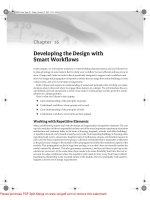Hydrodynamics Advanced Topics Part 16 ppt
Bạn đang xem bản rút gọn của tài liệu. Xem và tải ngay bản đầy đủ của tài liệu tại đây (356.69 KB, 8 trang )
Elasto-Hydrodynamics of Quasicrystals and Its Applications
435
are the same with those given in classical references for conventional fracture dynamics,
discussed in Fan’s monograph [1] in detail. At first the comparison to the classical exact
analytic solution is carried out, in this case we put
0
xy
ww
(i.e.,
12
0KKR
) for the
numerical solution. The comparison has been done with the key physical quantity—
dynamic stress intensity factor, which is defined by
0
0
( ) lim ( ) ( ,0, )
yy
xa
Kt x a x t
(10)
The normalized dynamic stress intensity factor can be denoted as
()/
static
II
Kt K
, in which
static
I
K
is the corresponding static stress intensity factor, whose value here is taken as
00
ap
. For the
dynamic initiation of crack growth in classical fracture dynamics there is the only exact analytic
solution— the Maue’s solution (refer to Fan’s monograph [1]), but the configuration of whose
specimen is quite different from that of our specimen. Maue studied a semi-infinite crack in an
infinite body, and subjected to a Heaviside impact loading at the crack surface. While our
specimen is a finite size rectangular plate with a central crack, and the applied stress is at the
external boundary of the specimen. Generally the Maue’s model cannot describe the interaction
between wave and external boundary. However, consider a very short time interval, i.e., during
the period between the stress wave from the external boundary arriving at the crack tip (this time
is denoted by
1
t
) and before the reflecting by external boundary stress wave emanating from the
crack tip in the finite size specimen (the time is marked as
2
t
). During this special very short time
interval our specimen can be seen as an “infinite specimen”. The comparison given by Fig. 3
shows the numerical results are in excellent agreement with those of Maue’s solution within the
short interval in which the solution is valid.
Our solution corresponding to case of
0
xy
ww
is also compared with numerical
solutions of conventional crystals, e.g. Murti’s solution and Chen’s solutions (refer to Fan [1]
and Zhu and Fan [9] for the detail), which are also shown in Fig. 3, it is evident, our solution
presents very high precise.
2.3.3 Influence of mesh size (space step)
The mesh size or the space step of the algorithm can influence the computational accuracy
too. To check the accuracy of the algorithm we take different space steps shown in Table 1,
which indicates if
0
/40ha
the accuracy is good enough. The check is carried out through
static solution, because the static crack problem in infinite body of decagonal quasicrystals
has exact solution given in Chapter 8 of monograph given by Fan [1], and the normalized
static intensity factor is equal to unit. In the static case, there is no wave propagation effect,
00
/3,/3La Ha
the effect of boundary to solution is very weak, and for our present
specimen
00
/4,/8La Ha
, which may be seen as an infinite specimen, so the normalized
static stress intensity factor is approximately but with highly precise equal to unit. The table
shows that the algorithm is with a quite highly accuracy when
0
/40.ha
2.4 Results of dynamic initiation of crack growth
The dynamic crack problem presents two “phases” in the process: the dynamic initiation of
crack growth and fast crack propagation. In the phase of dynamic initiation of crack growth,
the length of the crack is constant, assuming
0
()at a
. The specimen with stationary crack
Hydrodynamics – Advanced Topics
436
Fig. 3. Comparison of the present solution with analytic solution and other numerical
solution for conventional structural materials given by other authors
H a
0
/10 a
0
/15 a
0
/20 a
0
/30 a
0
/40
K 0.9259 0.94829 0.9229 0.97723 0.99516
Errors 7.410% 5.171% 3.771% 2.277% 0.484%
Table 1. The normalized static S.I.F. of quasicrystals for different space steps
that are subjected to a rapidly varying applied load
0
() ()
p
t
pf
t
, where
0
p
is a constant
with stress dimension and
()
f
t
is taken as the Heaviside function. It is well known the
coupling effect between phonon and phason is very important, which reveals the distinctive
physical properties including mechanical properties, and makes quasicrystals distinguish
the periodic crystals. So studying the coupling effect is significant.
The dynamic stress intensity factor
()Kt
for quasicrystals has the same definition given by
equation (10), whose numerical results are plotted in Fig. 4, where the normalized dynamics
stress intensity factor
00
()/Kt ap
is used. There are two curves in the Fig. 4, one
represents quasicrystal, i.e.,
/0.01RM
, the other describes periodic crystals
corresponding to
/0RM
, the two curves of the Fig. 4 are apparently different, though
they are similar to some extends. Because of the phonon-phason coupling effect, the
mechanical properties of the quasicrystals are obviously different from the classical crystals.
Thus, the coupling effect plays an important role.
In Fig. 4,
0
t
represents the time that the wave from the external boundary propagates to the
crack surface, in which
0
2.6735 μst
. So the velocity of the wave propagation is
00
/ 7.4807 km/sHt
, which is just equal to the longitudinal wave speed
1
(2)/cLM
. This indicates that for the complex system of wave propagation-motion
of diffusion coupling, the phonon wave propagation presents dominating role.
Elasto-Hydrodynamics of Quasicrystals and Its Applications
437
Fig. 4. Normalized dynamics stress intensity factor (DSIF) versus time
There are some oscillations of values of the stress intensity factor in the figure. These
oscillations characterize the reflection and diffraction between waves coming from the crack
surface and the specimen boundary surfaces. The oscillations are influenced by the material
constants and specimen geometry including the shape and size very much.
3. Elasto-/hydro-dynamics and applications to fracture dynamics of three-
dimensional icosahedral quasicrystals
3.1 Basic equations, boundary and initial conditions
There are over 50% icosahedral quasicrystals among observed the quasicrystals to date, this
shows this kind of systems in the material presents the most importance. Within icosahedral
quasicrystals, the icosahedral Al-Pd-Mn quasicrystals are concerned in particular by
researchers, for which especially a rich set of experimental data for elastic constants
accumulated so far, this is useful to the computational practice. So we focus on the elasto-
hydrodynamics of icosahedral Al-Pd-Mn quasicrystals here. From the previous section we
have known there are lack of measured data for phason elastic constants, the computation
has to take some data which are obtained by Monte Carlo simulation, this makes some
undetermined factors for computational results for decagonal quasicrystals. This shows the
discussion on icosahedral quasicrystals is more necessary, and the formalism and numerical
results are presented in the following.
If considering only the plane problem, especially for the crack problems, there are much of
similarities with those discussed in the previous section. We present herein only the part
that are different.
For the plane problem, i.e.,
()
0
z
(11)
Hydrodynamics – Advanced Topics
438
The linearized elasto-hydrodynamics of icosahedral quasicrystals have non-zero
displacements
,
zz
uw
apart from
,, ,
x
y
x
y
uuww
, so in the strain tensors
1
()
2
j
ii
ij ij
j
i
j
u
uw
w
xx x
it increases some non-zero components compared with those in two-dimensional
quasicrystals. In connecting with this, in the stress tensors, the non-zero components
increase too relatively to two-dimensional ones. With these reasons, the stress-strain
relation presents different nature with that of decagonal quasicrystals though the
generalized Hooke’s law has the same form with that in one- and two-dimensional
quasicrystals, i.e.,
i
j
i
j
kl kl i
j
kl kl i
j
kli
j
kl i
j
kl kl
CRwHRKw
In particular the elastic constants are quite different from those discussed in the previous
sections, in which the phonon elastic constants can be expressed such as
()
i
j
kl i
j
kl ik
j
lil
j
k
C
(12)
and the phason elastic constant matrix [K] and phonon-phason coupling elastic one [R] are
defined by the formulas of Fan’s monograph [1], which are not listed here again.
Substituting these non-zero stress components into the equations of motion
2
2
i
j
i
j
u
x
t
,
i
j
i
j
H
w
tx
(13)
and through the generalized Hooke’s law and strain-displacement relation we obtain the
final dynamic equations as follows
22
22 222
22222
11223
22 222
22 222
22
22222
21213
22 222
2
22
2
2
222
() ( 2 )
() ( 2 )
(
yy
xx x x x x
yy y y y y
xx
zz
uw
uu u u w w
ccccc
txy xy
tx yxy
uu u u w w
uw
ccccc
txy xy
tx yxy
uu
c
t
txy
2
22 22
2
3
22 22
2
2222
22 22
123
22 22 2 2 2 2
)( 2 )
()()(2 )
y
xx zz
z
y
x xxzz
xxz
w
ww ww
uc
xy
xy xy
u
wuuuu
wd wd wd
txy
x
y
x
y
x
y
x
y
22
222
22
123
22 2 2
2
22
22 22
12 2 3
22 2 2 22
() (2 2)
()( ) ( 2)( )
yyy
zxz
yy
y
zxx
zz z
wuu
wuu
wd wd d
txyxyxy
xy x y
w
www
wdd wd d u
txy
xy x y xy
(14)
Elasto-Hydrodynamics of Quasicrystals and Its Applications
439
in which
12
123123
2
,,,, d,
RK K R
cccd d
(15)
note that constants
12
,cc
and
3
c
have the meaning of elastic wave speeds, while
12
,dd
and
3
d
do not represent wave speed, but are diffusive coefficients and parameter
may be
understood as a manmade damping coefficient as in the previous section.
Consider an icosahedral quasicrystal specimen with a Griffith crack shown in Fig. 1, all
parameters of geometry and loading are the same with those given in the previous, but in
the boundary conditions there are some different points, which are given as below
0, 0, 0, 0, 0, 0 on 0 for0
0, 0, 0, 0, 0, 0 on for0
(), 0, 0, 0, 0, 0 on for0
0, 0, 0, 0, 0, 0 on 0 for0 ( )
0
xyxzxx yx zx
xx yx zx xx yx zx
yy xy zy yy xy zy
yy xy zy yy xy zy
y
uwHHx
y
H
HHH xL
y
H
p
t HHH
y
HxL
HHH
y
xat
u
, 0, 0, 0, 0, 0 on 0 for ( )
xyzyyxyzy
wH H
y
at x L
(16)
The initial conditions are
000
000
000
(,,) 0 (,,) 0 (,,) 0
(,,) 0 (,,) 0 (,,) 0
(,,)
(,,) (,,)
000
xt yt zt
xt yt zt
y
xz
ttt
u xyt u xyt u xyt
w xyt w xyt w xyt
uxyt
u xyt u xyt
ttt
(17)
3.2 Some results
We now concentrate on investigating the phonon and phason fields in the icosahedral Al-
Pd-Mn quasicrystal, in which we take
3
5.1 g/cm
and
74.2 GPa, 70.4 GPa
of the
phonon elastic moduli, for phason ones
12
72 MPa, 37 MPaKK
and the
constant relevant to diffusion coefficient of phason is
19 3 10 3
1/ 4.8 10 m s/kg=4.8 10 cm μs/g
w
. On the phonon-phason coupling
constant, there is no measured result for icosahedral quasicrystals so far, we take
/0.01R
for quasicrystals, and
/0R
for “decoupled quasicrystals” or crystals.
The problem is solved by the finite difference method, the principle, scheme and algorithm are
illustrated as those in the previous section, and shall not be repeated here. The testing for the
physical model, scheme, algorithm and computer program are similar to those given in Section 2.
The numerical results for dynamic initiation of crack growth problem, the phonon and
phason displacements are shown in Fig. 5.
The dynamic stress intensity factor
()Kt
is defined by
0
0
( ) lim ( ) ( ,0, )
yy
xa
Kt x a x t
and the normalized dynamics stress intensity factor (D.S.I.F.)
00
() ()/Kt Kt ap
is used,
the results are illustrated in Fig. 6, in which the comparison with those of crystals are shown,
one can see the effects of phason and phonon-phason coupling are evident very much.
Hydrodynamics – Advanced Topics
440
Fig. 5. Displacement components of quasicrystals versus time.
(a)displacement component
x
u
; (b)displacement component
y
u
;
(c)displacement component
x
w
;(d)displacement component
y
w
For the fast crack propagation
problem the primary results are listed only the dynamic stress
intensity factor versus time as below
Fig. 6. Normalized dynamic stress intensity factor of central crack specimen under impact
loading versus time
Elasto-Hydrodynamics of Quasicrystals and Its Applications
441
Fig. 7. Normalized stress intensity factor of propagating crack with constant crack speed
versus time.
Details of this work can be given by Fan and co-workers [1], [10].
4. Conclusion and discussion
In Sections 1 through 3 a new model on dynamic response of quasicrystals based on
argument of Lubensky et al is formulated. This model is regarded as an elasto-
hydrodynamics model for the material, or as a collaborating model of wave propagation
and diffusion. This model is more complex than pure wave propagation model for
conventional crystals, the analytic solution is very difficult to obtain, except a few simple
examples introduced in Fan’s monograph [1]. Numerical procedure based on finite
difference algorithm is developed. Computed results confirm the validity of wave
propagation behaviour of phonon field, and behaviour of diffusion of phason field. The
interaction between phonons and phasons are also recorded.
The finite difference formalism is applied to analyze dynamic initiation of crack growth and
crack fast propagation for two-dimensional decagonal Al-Ni-Co and three-dimensional
icosahedral Al-Pd-Mn quasicrystals, the displacement and stress fields around the tip of
stationary and propagating cracks are revealed, the stress present singularity with order
1/2
r
, in which
r
denotes the distance measured from the crack tip. For the fast crack
propagation, which is a nonlinear problem—moving boundary problem, one must provide
additional condition for determining solution. For this purpose we give a criterion for
checking crack propagation/crack arrest based on the critical stress criterion. Application of
this additional condition for determining solution has helped us to achieve the numerical
simulation of the moving boundary value problem and revealed crack length-time
evolution. However, more important and difficult problems are left open for further study.
Up to now the arguments on the physical meaning of phason variables based on
hydrodynamics within different research groups have not been ended yet, see e.g. Coddens
[11], which may be solved by further experimental and theoretical investigations.
Hydrodynamics – Advanced Topics
442
5. References
[1] Fan T Y, 2010, Mathematical Theory of Elasticity of Quasicrystals and Its Applications,
Beijing:Science Press/Heidelberg:Springer-Verlag.
[2]
Lubensky T C , Ramaswamy S and Joner J, 1985, Hydrodynamics of icosahedral
quasicrystals, Phys. Rev. B, 32(11), 7444.
[3]
Socolar J E S, Lubensky T C and Steinhardt P J, 1986, Phonons, phasons and dislocations
in quasicrystals, Phys. Rev. B, 34(5), 3345.
[4]
Rochal S B and Lorman V L, 2002,Minimal model of the phonon-phason dynamics on
icosahedral quasicrystals and its application for the problem of internal friction in
the i-AIPdMn alloys, Phys. Rev. B, 66 (14), 144204.
[5]
Fan T Y , Wang X F, Li W et al., 2009, Elasto-hydrodynamics of quasicrystals, Phil. Mag.,
89(6),501.
[6]
Chernikov M A, Ott H R, Bianchi A et al., 1998, Elastic moduli of a single quasicrystal of
decagonal Al-Ni-Co: evidence for transverse elastic isotropy, Phys. Rev. Lett. 80(2),
321-324.
[7]
H. C. Jeong and P. J. Steinhardt, 1993, Finite-temperature elasticity phase transition in
decagonal quasicrystals , Phys. Rev. B 48(13), 9394.
[8]
Walz C, 2003, Zur Hydrodynamik in Quasikristallen, Diplomarbeit, Universitaet
Stuttgart.
[9]
Zhu A Y and Fan T Y, 2008, Dynamic crack propagation in a decagonal Al-Ni-Co
quasicrystal , J. Phys.: Condens. Matter, 20(29), 295217.
[10]
Wang X F, Fan T Y and Zhu A Y, 2009, Dynamic behaviour of the icosahedral Al-Pd-Mn
quasicrystal with a Griffith crack, Chin Phys B, 18 (2), 709.( or referring to Zhu A Y:
Study on analytic and numerical solutions in elasticity of three-dimensional
quasicrystals and elastodynamics of two- and three-dimensional quasicrystals,
Dissertation, Beijing Institute of Technology, 2009 )
[11]
Coddens G, 2006, On the problem of the relation between phason elasticity and phason
dynamics in quasicrystals, Eur. Phys. J. B, 54(1), 37.









